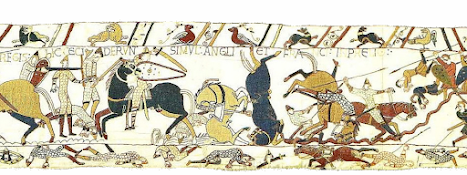Where did William land at Hastings?
In this post I'd like to discuss where William landed at the port of Hastings. This is not about the knights leaving Hastings on the night prior to the battle but rather about where the foot of the Norman invader touched English mainland soil. To start, I'm going to use a page out of Hastings Historic Character Assessment Report April 2010.
https://www.westsussex.gov.uk/media/1728/hastings_eus_report_maps.pdf
The above irl refers to a map of the underlying geology of Hastings Town centre. You will notice the extensive deposits of alluvium on what is now dry land ( alluvium is deposited by rivers?). At one point in time there must have been a large river emptying into the sea here thus making a good harbour.
Key: Green = land, Orange = water in the time of 1066, Blue = present day sea extent.
Here's what I think the inlet would have looked like back in 1066.
Now, the default wind direction is from the South west so any captain would have sought out a landing place on the western shore of an inlet subject to terrain. Also William had to move men and material from the shore inland to conquer it(!).
We have no written accounts of where exactly William landed so all we have to go on is speculation.
The present narrative calls for William to build a fort at Hastings which is remodelled in stone at a later date. So, the stone castle on the West Hill is thought to be the site of an early wooden fort built at the time of conquest. However, there is a problem with this thought. As any resident of Hastings knows, the land between say the present railway viaduct and Hastings Castle consists of a narrow strip of flat land backed by a very steep slope to the top of the ridge that ends with the castle. I would imagine in geological terms that the river that flowed out here washed away the eastern bank. Another thing to take account is the river bed when it went past the entrance to the inlet.
Although this shows the modern ground level it echos what would have been the channel back in 1066. That is, the deepest part of the channel would have been closer to the castle. So in my opinion the castle was built there to protect the harbour from any seabourne invasion.
My theory is that William first touched English mainland soil in the vicinity of where Hastings Priory was built. Firstly, it is on the western edge of the inlet thus protected from the dominant wind. Secondly, it has the shortest route to the ridge behind Hastings without any undo elevation climbs. And thirdly, a Priory was built as a sort of "blue plaque" in honour of William and authorised between 1189 and 1199 ( reign of Richard the Lionheart).





